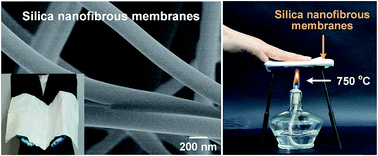Silica nanofibrous membranes with ultra-softness and enhanced tensile strength for thermal insulation†
Abstract
Novel silica nanofibrous (SNF) membranes with ultra-softness and enhanced tensile strength were prepared for the first time via an electrospinning technique with a sol–gel solution containing NaCl. By employing NaCl incorporation, the bonding structure was formed between silica nanofibers, which significantly enhanced the tensile strength of the SNF membranes from 3.2 to 5.5 MPa. Meanwhile, the morphology and mechanical properties of the SNF membranes can be finely controlled by tuning the calcination temperature and varying the NaCl content in the precursor solution. Additionally, the proposed mechanism of the softness of the SNF membranes was discussed by in situ SEM analysis during the bending and recovery process. Furthermore, the as-prepared SNF membranes with ultra-softness of 40 mN and relative high tensile strength of 5.5 MPa exhibit an ultra-low thermal conductivity of 0.0058 W m−1 K−1, even lower than air, which suggested them to be promising candidates for bunker clothing. This novel method also provides a new insight into the design and development of other soft ceramic nanofibrous membranes with high tensile strength for various applications.


 Please wait while we load your content...
Please wait while we load your content...